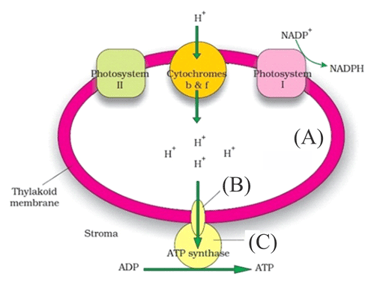EASY
Earn 100
What is adenosine triphosphate made of ?
Important Questions on Photosynthesis
EASY
MEDIUM
Assertion A: During photophosphorylation protons are transported across the membrane and accumulated inside the lumen.
Reason R: To develop proton gradient, pheophytin transfers electrons to hydrogen carriers instead of electron carrier.
EASY
Which of the following are required for chemiosmosis?
I. A membrane
I. A neutron pump
II. An electron gradient
IV.
The correct answer is:
MEDIUM
MEDIUM
MEDIUM
EASY
MEDIUM
EASY
EASY
MEDIUM
Identify the parts marked as and in the given figure showing ATP synthesis through chemiosmosis.
** Options were incomplete and changes were made accordingly.
EASY
EASY
HARD
EASY
EASY
MEDIUM
MEDIUM
Statement I: In photosynthesis, during ATP synthesis, protons accumulate in the lumen of thylakoid.
Statement II: In respiration, during ATP synthesis, protons accumulate in the intermembranal space of mitochondria.
EASY
EASY

